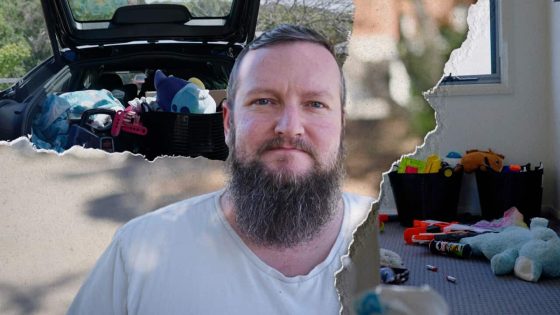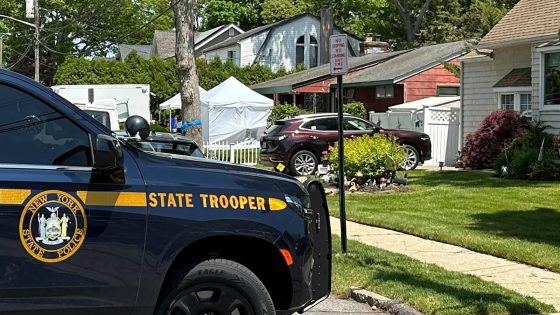Content warning: distressing content, discussions of suicide and domestic violence
On Jake’s final day in his house, he packs up all signs of the six years he spent here into cardboard boxes. The boxes are destined for his storage unit down the road, but he has nowhere to go.
Inching closer to his first night of homelessness, Jake, 37, told The Feed he hasn’t really been able to soak up the last few nights in the house.
“I’ve been having trouble sleeping. I would work all night and come home, and I would feel tired and I would just lay in bed constantly thinking, ‘What am I doing tomorrow? What’s my plan here?'”
The plan is to sleep in his car. After spending all day working as a rideshare driver, he’ll now spend all night in it, too.
“You kind of feel like a failure. You can’t put a roof over your head and you can’t have your kids,” he told The Feed. Before this day, Jake had his kids two nights a week.
Jake was evicted from his rental after he fell behind on payments following a rental increase. Source: SBS
“I really can’t do that anymore,” he said.
“I might be able to take them out to the park or something,” he says, thinking out loud, but the thought of the adjustment leaves him in tears.
The lead-up to this point is a familiar tale. “Cost of living, decreased income, rent increase. Going from a dual income to a single income,” Jake rattles off, adding that his rent went from $500 to $650 a week.
After oscillating between paying and falling behind on rent, Jake received a 14-day eviction notice.
“I [was] busting my ass here to pay for rent in a place and I was never here,” he said.
Last year, 6,250 people, including families, reported that they were living in their cars, according to the Australian Institute of Health and Welfare. This was the biggest year-on-year increase in a decade.
Some people like Jake aren’t even reporting to a homelessness support service and are living in their cars until something comes through.
The number of people living in their cars last year had the biggest year-on-year increase. Source: SBS
Last year, Homelessness Australia, the peak body for homelessness in the country, reported that demand for support services rose 7.5 per cent. The cost of living and the housing crisis were cited as the two key reasons for the increase.
On the first night of sleeping in his car, Jake says: “I’ve just got a pillow and blanket, and I’ll have some spare clothes.”
“I still have to work. I still have to use the car for Uber, I can’t have just stuff everywhere.”
Now, the worry that plagues his downtime is his rental ledger, which marks weeks of falling behind.
And in a competitive market, he says: “As soon as they see that, it’s just going to be on to the next application.”
Jason*: ‘It’s a nightmare that you can’t wake up from’
Australians and others abroad are using Reddit to connect on forums dedicated to car living. In posts, they swap teachings.
Garbage bags will block out the sun. Parking near a beach will help with the heat. And if you’re picking a car to invest in, electric vehicles are preferable as you can keep climate control on at night without killing your battery, they write.
Queenslander Jason is a regular poster on these forums when he first connects with The Feed. But he wishes he wasn’t.
For three months at the end of last year, Jason was living in his car with his autistic son. “He used to be the sweetest boy,” Jason told The Feed. “Now he’s just become nonverbal and not engaging with anyone.”
Jason, who has osteoporosis and gets around on a walking frame, slept in the front so that his son could sleep in the back. With a handbrake between the seats, he was left with little choice but to sleep upright.
In the early days of it all, he parked in front of the local police station in an attempt to quell his son’s fears of being so exposed at night. It helped a little, but the fears were always around and changed shape every day.
On Reddit forums, Australians like Jake are swapping lessons on how to cope with living in their cars. Source: SBS
“He doesn’t understand why we don’t have our old house … he still talks about that place,” he said.
“Many a time, when he’s asleep, I just silently cry.”
Before this, Jason, 53, and his son, 23, were sleeping in a caravan owned by some of their family when he was forced out.
On the Sunshine Coast, where they were living in an old four-wheel drive, Jason says small tasks like finding a toilet and preparing meals were taxing chores.
“I ended up in hospital with panic attacks just from worrying about every little movement (of my son),” he said.
A recreation of Jake’s three months living in his car with his son. Source: SBS
With a Disability Support Pension as an income, he says that the sum of $1,064 per fortnight makes it impossible to rent. Last year, found that 0.1 per cent of listings — or just 66 rentals — were affordable on the payment after surveying listings across Australia.
“Every day you try. I’ve been listening to people on YouTube talk about setting the tiniest goals to get something done each day,” he said last year.
“And if you get that goal done today – then you’ve done something,” he said. “That only gets you so far.”
On the day we planned to meet up for an in-person interview, Jason reached out to me, expressing suicidal ideation.
“I have decided to take my own life due to the pressure of being homeless with my autistic son, I just can’t take it anymore,” he wrote in a message to me, giving permission to share conversations from previous phone interviews.
Jason was in contact with his GP and is now in a better place. He also has housing through the Salvation Army.
“Feeling like nobody knows what’s happening to you can be a scary feeling. I want people to know there are people suffering, and we have suffered.”
Nicole*: ‘Do we just go homeless to save our children and ourselves’
In December, Nicole’s eldest asked her if Santa would know where to find them now that they live at a campsite full-time.
As frequent campers, the first little while was cheerful enough, but now living out of a 2004 four-wheel drive and a tent is drawing questions from Nicole’s eight-year-old. Questions she doesn’t have the answers to.
“It’s heartbreaking. She’s old enough to know what’s going on,” Nicole told The Feed, saying the health of her kids had significantly deteriorated in the three months of living like this.
The next time this happens, I’m going to die and my kids are going to have no one.
Nicole, 28
Nicole, 28, suspected that she and her three kids would be homeless months before it happened. In a small house already trying to afford a new rental increase, she searched for another place where she hoped her former partner would not be able to find her. Although they had separated, he had turned up unannounced a few times before.
But a new place never came and applications were rejected again and again.
For months, she stayed in the property where she had experienced domestic violence, fearing more. A new report from Homelessness Australia confirms this is not uncommon.
One question tormented Nicole: “Do we just go homeless to save our children and ourselves?”
“It got to the point where I was like, the next time this happens, I’m going to die and my kids are going to have no one.”
Domestic and family violence is the leading cause of homelessness for women, with 45 per cent of women and girls seeking homelessness support identifying family and domestic violence as a cause. Financial difficulties (39 per cent), housing crisis (36 per cent) and housing affordability stress (32 per cent) are the second, third and fourth reasons identified in the report.
Reasons identified for seeking homelessness assistance by women and girls. Source: SBS
In the last financial year, homelessness services helped 96,414 people who had experienced family and domestic violence. Of them, 2,428 were sleeping rough or in a car.
Nicole was self-employed and working out of her house before the family of four became homeless. She says her rental record was fantastic and she could, on paper, afford some of the properties she had applied to — but in a competitive market, she couldn’t land one.
Now, her money is eaten up by storage unit and campsite fees, fuel and car maintenance, and groceries that can be used within the day now that she doesn’t have a fridge.
“My children are all I have, so I have to be strong for them,” she said, “But if I didn’t have kids and I was homeless, I understand why some people that are homeless prefer to just let themselves go.”
Most days her three kids under eight sleep in a tent. She sleeps in a pop-up gazebo next to them. Grief comes on rainy days when the four of them cram inside the car.
Safe parking lots have grown in popularity across the West Coast in the US since the first one was established in 2004. Source: Getty / Genaro Molina, Los Angeles Times
Support services in the area are at their limit, and those with some capacity to offer temporary housing are too far away, especially when her daughter’s primary school anchors them to the local area.
“I used to think, ‘Oh, you’re homeless. You messed up.’ But no, a lot of us just can’t afford to live in a house.”
Nicole is expecting social housing imminently.
In the US, safe parking lots a growing response
In Australia, people living in their cars have reported harassment from strangers and pushback from councils that want to reduce overnight stays in the areas where they park.
In America, one of the fastest growing parts of the homeless population are people who live in their cars, caravans and other vehicles.
Designated safe parking lots are a growing response in the US, which some say addresses a community need.
There’s a locked gate, the address is only shared with those who need it, there is plenty of light, and it is intended to reduce theft and harassment.
Pictures from safe parking lots across the US. Professor Cameron Parsell says Australia should not ‘normalise poverty’ and do better. Source: Getty / Jane Tyska/Digital First Media/The Mercury New
But Professor Cameron Parsell, who studies marginalisation and homelessness at the University of Queensland, says we should never consider it.
“Some organisations or councils around Australia are making available car parks in churches or shopping centres where people can sleep rough, trying to support people in their cars.”
“It’s a very, very, very low bar if society can only sit by and try and change some (policy) so that people can freely and legally sleep in their cars.”
In his eyes, there’s only one helpful pathway.
“All of the evidence says if there’s more social affordable housing, there’s less homelessness,” he said.
“Everyone deserves housing, safe, affordable housing for no other reason than our shared humanity.”
*Names have been changed.
Readers seeking crisis support can contact Lifeline on 13 11 14, the Suicide Call Back Service on 1300 659 467 and Kids Helpline on 1800 55 1800 (for young people aged up to 25). More information and support with mental health is available at and on 1300 22 4636.
supports people from culturally and linguistically diverse backgrounds.
If you or someone you know is impacted by family and domestic violence, call 1800RESPECT on 1800 737 732, text 0458 737 732, or visit . In an emergency, call 000.
, operated by No to Violence, can be contacted on 1300 766 491.










